Food & Drink
Heirloom Fish Peppers Carry on the Story of African-American Cookery in Maryland
Meet the farmers and chefs who have ushered in the next renaissance of the fruity, floral, spicy chiles in Baltimore.
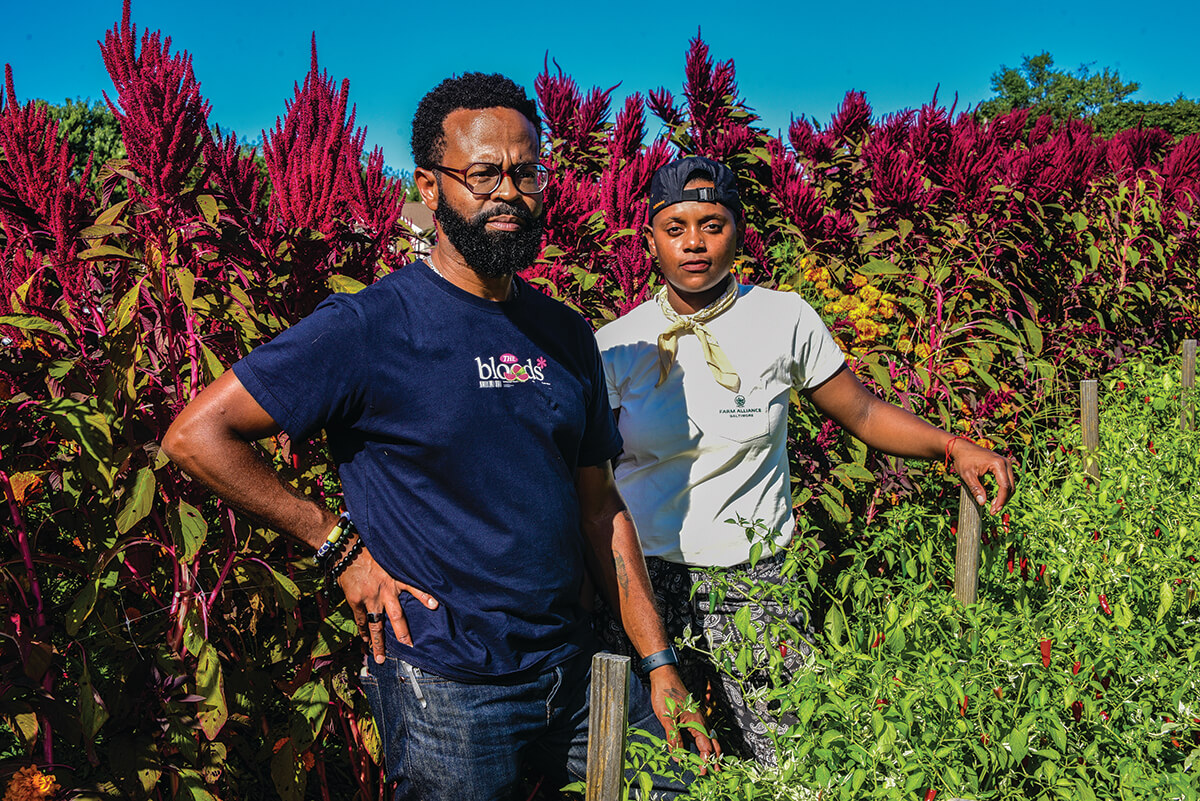
On a warm morning in late August, Myeasha Taylor wades down a row of nearly waist-high greenery at Black Butterfly Farm, a teaching urban farm on 6.7 acres in Curtis Bay that’s part of the nonprofit Farm Alliance of Baltimore. Taylor, the farm’s education and production manager, picks a handful of ripe fish peppers—bright red chiles about the size of small jalapeños—from among the 100 “row feet” of plants running down the plot between columns of indigo, flowering okra, and red amaranth taller than she is. Bees weave through the summer air. Butterflies alight on the tallest sun-drenched plants.
“This is our little ancestral crop section,” says Taylor as she lifts a tangle of vines woven through a line of near-invisible trellises. Most of the peppers are still the same shade as the leaves surrounding them, some are painted in stunning kelly-green and orange stripes, some are vermillion, still others the color of butter. A few are white, a distinction that gave the fish pepper its name, as it was favored by cooks in 19th-century Chesapeake Bay oyster and crab houses for use in their fish stews, disappearing into pale, creamy soups, and before that, in Black communities in the Mid-Atlantic where the peppers were grown and used in fish and seafood cookery.
That fish peppers are now growing in this South Baltimore field, are being sold at the 32nd Street Farmers Market, and are on the menu of such places as Blacksauce Kitchen, Artifact Coffee, and Spike Gjerde’s Woodberry Tavern—where they’re used so liberally, the peppers have their own mis en place containers at the chefs’ stations—is largely because of Denzel Mitchell Jr.
Mitchell, the Oklahoma native who is one of the founders of the Farm Alliance and is currently its executive director, got interested in urban farming 15 years ago. That was also when he first learned about fish peppers from a local farmer. He had never heard of them.
“So, I go home, I look up the fish pepper, and find out that it’s intrinsically connected to the enslaved African experience in the Chesapeake. It has a storied history in Maryland,” says Mitchell.
Captivated, he went to local nurseries and farmers markets, thinking he’d have no problem finding the peppers—but to his surprise, no one was growing them. It was as if the pepper, once so widely found in fish houses that it was named after them, had disappeared.
Mitchell is a cook at Blacksauce Kitchen, the Remington restaurant he helped Damian Mosley open in 2016 that specializes in barbecue and biscuits. Blacksauce uses fish peppers in a house-made hot sauce, in fish sandwiches, in mayonnaise, and in other seasonal preparations. As he shares his fish pepper origin story from Blacksauce’s tiny dining room, he pauses, disappearing into the back and returning with a Mason jar of pickled fish peppers. He opens the jar, adding a few peppers to a dish of curried chickpeas on a Trinidadian flatbread known as bara. The peppers are fruity, floral, with a heat similar to a serrano—spicy but not bitter.
“The story of the fish pepper really spoke to me,” he says, lifting more peppers from the jar. “It was an homage to enslaved African foodways, and that influence in Chesapeake Bay cuisine, that connection to the cuisine in this region—it was the most popular pepper in the fish houses, so there’s this heritage.”
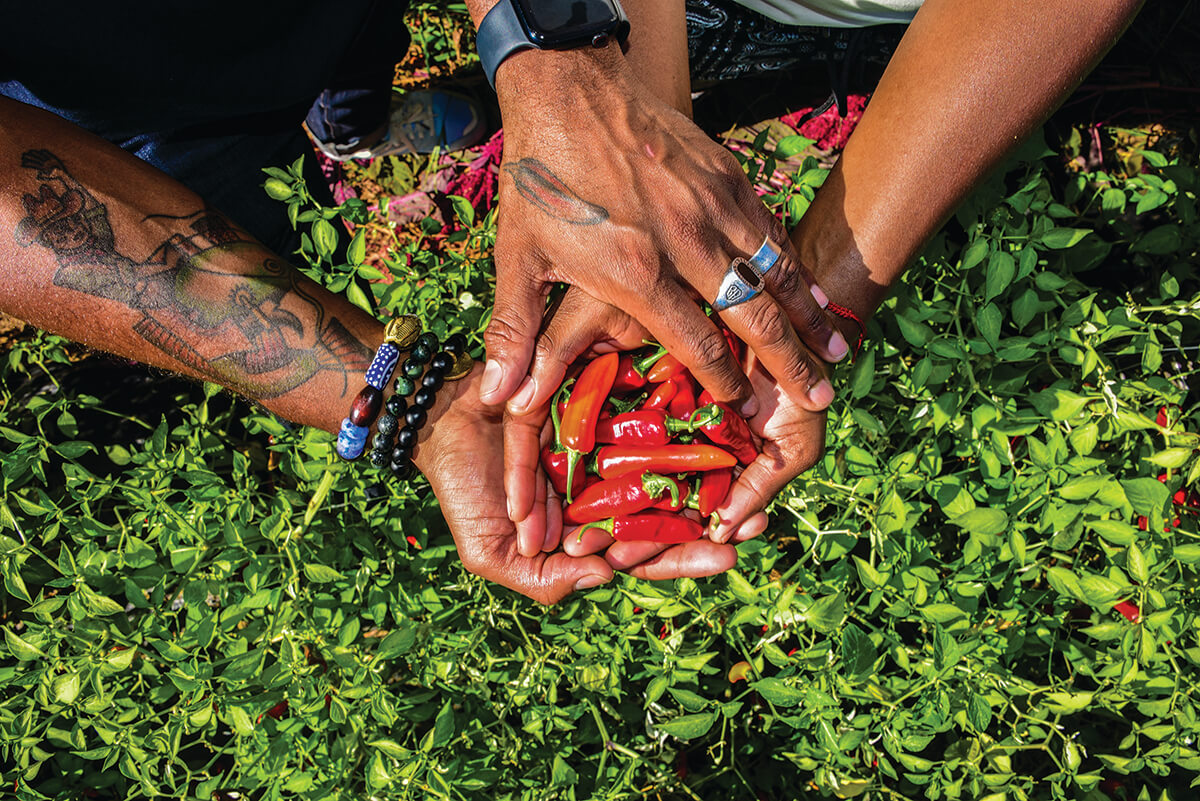
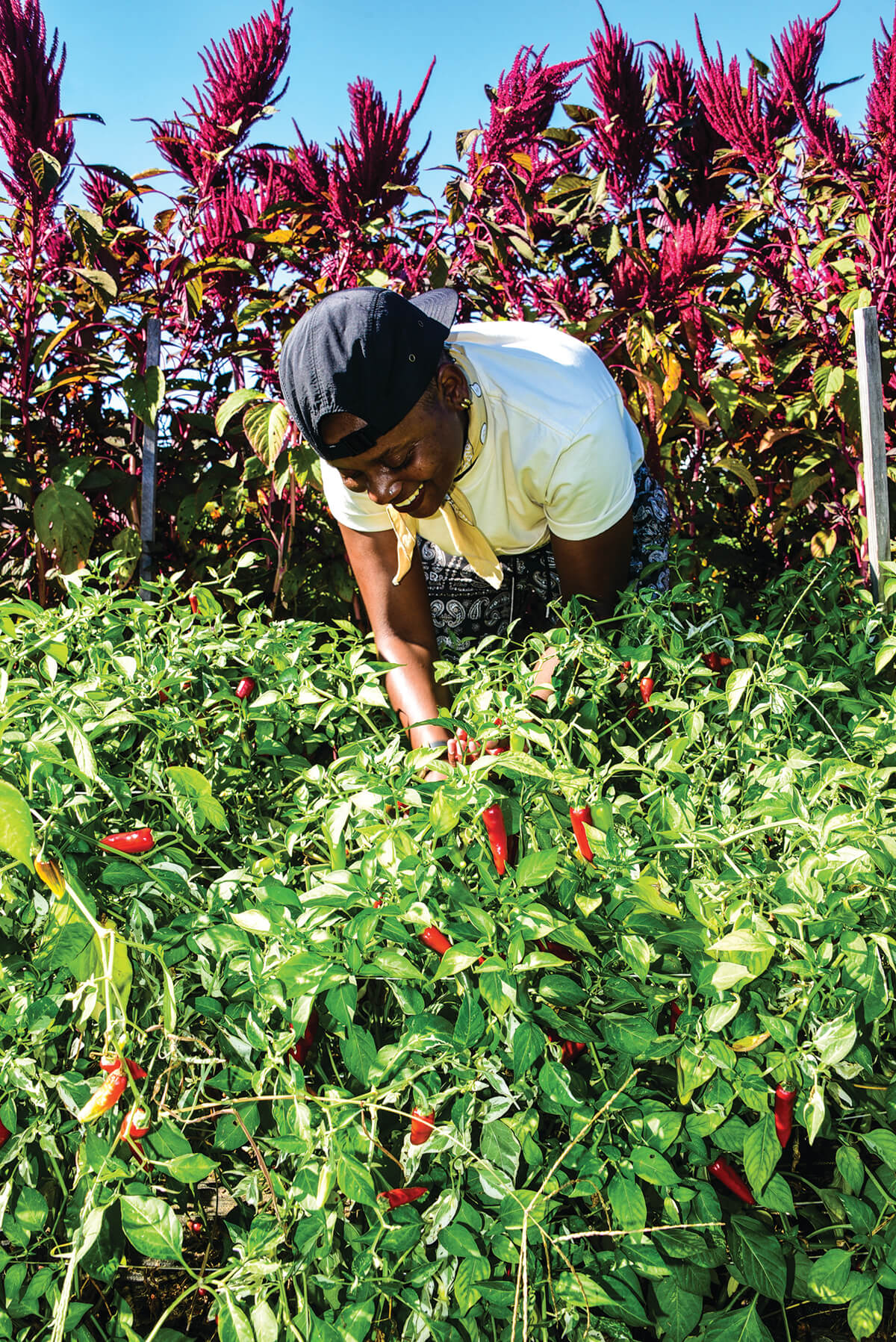
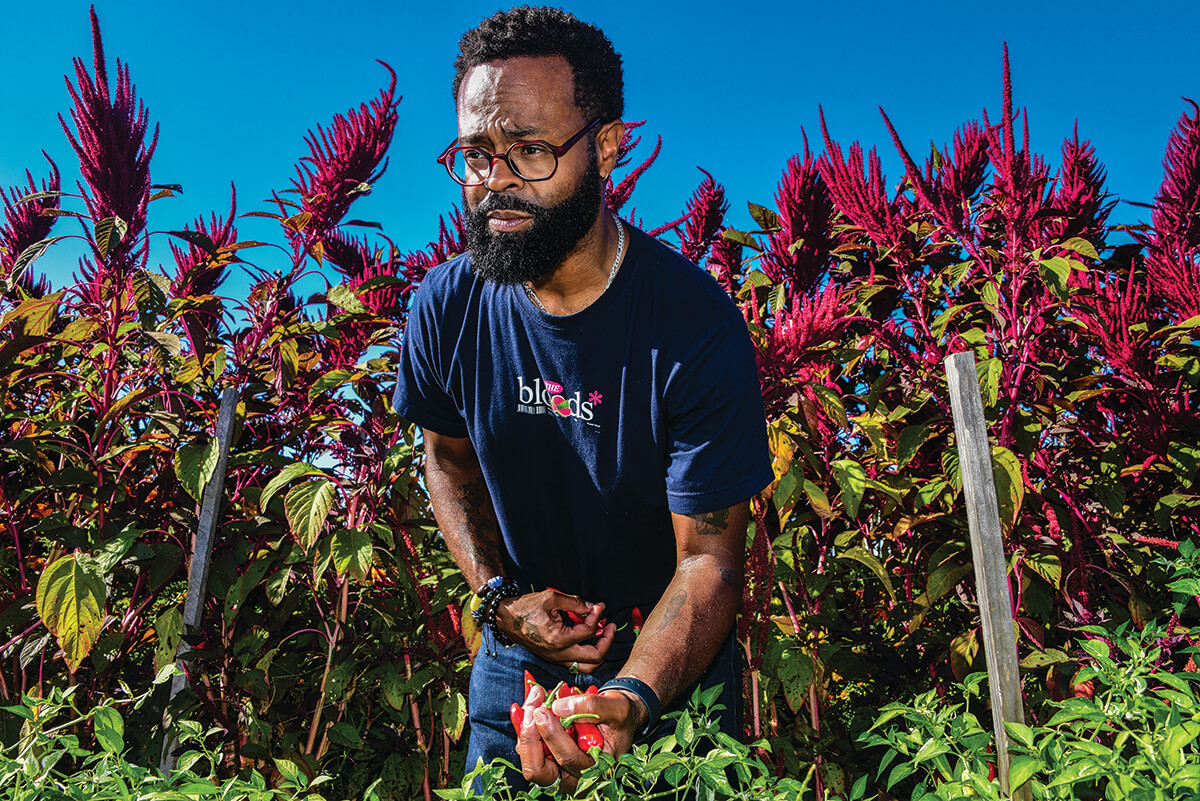
Mitchell’s initial research led him to the culinary historian Michael W. Twitty, author of the James Beard Award-winning book The Cooking Gene, who specializes in traditional African-American foodways. Twitty had curated an African-American heritage seed collection, the first of its kind, with the Landreth Seed Company. (Founded in Philadelphia in 1784, Landreth is the oldest seed company in the U.S.)
Twitty theorizes that Haitians fleeing the Haitian Revolution, a rebellion of the enslaved against French colonial rule in the late 1700s, initially brought fish pepper plants to the Mid-Atlantic, where the peppers were grown by enslaved Africans and became popular in Black community cooking and later among regional fish houses. Then by the early 20th century, due to urbanization and changing food styles, the pepper was largely forgotten, absent from regional cookbooks, missing from farms, and impossible to find in the ground.
“When you’re erased from history, what can you do? Things disappear because people get exhausted, even when things taste good. It’s simply not worth the time anymore,” says Twitty, speaking, of course, not just about the trajectory of the fish pepper.
The preservation and subsequent rediscovery of the pepper happened largely by accident. Sometime in the 1940s, a Black artist from southeastern Pennsylvania named Horace Pippin traded some fish pepper seeds with Pennsylvania beekeeper and seed collector H. Ralph Weaver in exchange for bee stings to treat his arthritis. (Bee stings have long been used as a therapy for joint pain.) Years later, that beekeeper’s grandson, food ethnographer William Woys Weaver, found his grandfather’s seeds, realized how rare they were, started growing them, and introduced the seeds to the Seed Savers Exchange.
“They were in the freezer at my grandfather’s house,” says Weaver now, noting that properly frozen seeds will keep for many years. “I’ve planted corn frozen in 1999 and gotten 100-percent germination,” he says, adding that wheat can keep for 1,000 years. “He had them all in little baby food jars at the bottom of the deep-freeze. Probably my baby food jars because my grandparents raised me,” says Weaver. “I had [seeds] that nobody could find at that time.”
“THE STORY OF THE FISH PEPPER WAS AN HOMAGE TO ENSLAVED AFRICAN FOODWAYS.’’
Many years after that, Mitchell would order seeds whose lineage can be traced back to Pippin’s bartered handful and begin the next renaissance of the fish pepper in Baltimore.
Not long after Mitchell started growing his 21st-century fish peppers, he ran into Spike Gjerde—one of the foremost chefs in the region and the only Baltimore chef to have won the James Beard Foundation’s Best Chef Mid-Atlantic award—and the two got to talking about produce, as food people do. As Mitchell tells it, Gjerde stopped in his tracks when he found out what Mitchell was growing. “He was like, ‘Fish peppers! Fish peppers? Where? Can we go right now?’” Mitchell smiles, considering the jar in front of him, filled with its deeply aromatic crimson treasure.
At the time, Mitchell was farming on six vacant lots in Baltimore’s Belair-Edison neighborhood. “I only had 15 plants, but no one else was growing them,” says Mitchell, whose Five Seeds Farm, which closed in 2016, is now the site of Hillen Homestead’s flower farm. “Spike wanted to get Tabasco out of his restaurant and have a Maryland hot sauce that represented Maryland cuisine on Chesapeake oysters, grown by Maryland farms.” Gjerde bought all the peppers Mitchell had. Soon he was growing enough peppers so that Gjerde could start making Snake Oil, his own brand of hot sauce, a heady mixture of mashed fish peppers, cider vinegar, and sea salt that’s sold at Artifact Coffee and used in abundance at Gjerde’s restaurant, Woodberry Tavern.
Back at Black Butterfly Farm, Taylor says they’d recently started harvesting the season’s fish peppers—55 pounds of them had just gone to Woodberry. “They’re easy to grow. And they’re easy to pick; they just take a long-ass time,” she says, smiling under her broad sun hat.
For years, the Farm Alliance has been buying fish pepper seeds each season—these days primarily from the Southern Exposure Seed Exchange—but this year, says Taylor, they’ll probably start saving some of their own seeds as well. “Seed saving is really important,” she continues, noting how the peppers were off the market for so long and that Farm Alliance gets funding for ancestral crops through a grant from the Northeast Sustainable Agriculture Research and Education organization. The practice, of course, is also how the pepper survived in the first place.
Taylor surveys the adjacent crops—in addition to the amaranth and indigo, there are rows of sweet potatoes, green beans, tomatoes, and bright marigolds nestled below the amaranth like stray bursts of gold. Those crops will head to Farm Alliance’s market stall at the 32nd Street Farmers Market in Waverly, and many of the peppers will migrate to Gjerde’s kitchen.
“I became aware of fish peppers from reading about them, from accounts by Michael Twitty and William Woys Weaver, because they weren’t around,” says Gjerde, sitting on the patio outside his restaurant one afternoon. “I started asking people about fish peppers, and it was really Denzel who found me.”
When Gjerde went to Mitchell’s farm for the first time, the chef still hadn’t even seen a fish pepper, much less tasted one. “They’re bright, hot, not as aggressively spicy as habañeros, with a grassy quality. That was the first time I’d ever seen an albino [pepper],” Gjerde says. “We even tried to make a white hot sauce, but it was a kind of unappealing tan.” Gjerde smiles ruefully as he considers the notion of beige hot sauce. “We’ve made green Snake Oil in the past, but we mostly just use the red. Anytime we’re adding heat or spice to cooking at Woodberry, it’s through pickled fish pepper, dried fish pepper, or Snake Oil.”
Although the production of Snake Oil paused during the pandemic, Gjerde says they’ve got a healthy supply of it, in the form of about 100 cases of bottles and 50 barrels of pepper mash, and he’s planning to jumpstart production soon. Gjerde likes the rather histrionic appeal of his hot sauce’s name, as “snake oil” has long been used to describe cure-all elixirs.
“It’s not hot hot. We always have to relieve people of the notion that it’s gonna, like, hurt them.”
He looks over his latest menu, cataloging the dishes that use fish pepper: on the deviled eggs and the crudites that make up the Tavern Board, in the scrapple musubi, the pit-beef carpaccio, the smoked-clam savory pie, the fried chicken, the crab cake, and the steak au poivre. So, most of the dishes on the menu? “Yeah,” he says, with a rather startled laugh, “now that you mention it.”
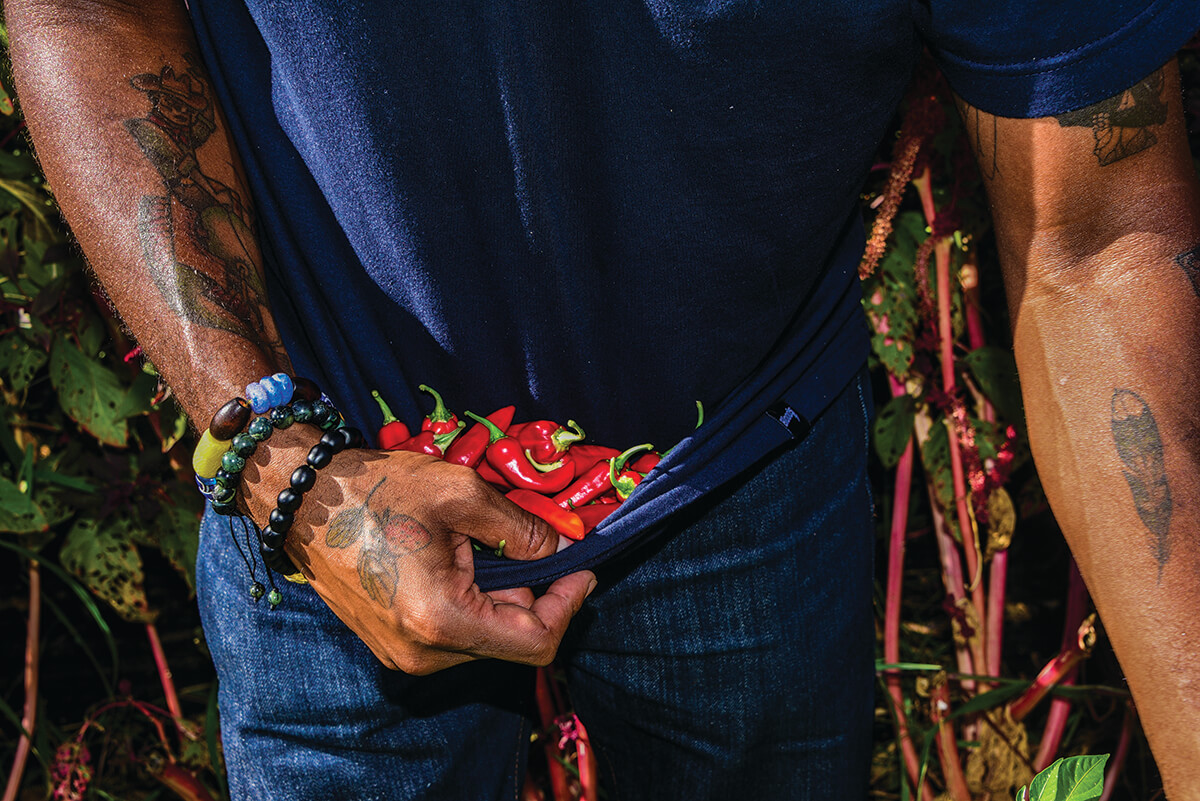
These days Mitchell is not the only local farmer growing fish peppers. Gjerde’s personal culinary obsession, running to thousands of pounds of the peppers a year, requires sourcing beyond the Farm Alliance’s fields, and has expanded to include One Straw Farm in northern Baltimore County, Heritage Acres Farm in Pennsylvania, and 78 Acres in Smithsburg, all of whom now grow fish peppers, too.
As more people have become aware of the cultural history and importance of local produce and demand has grown, more farms have added the peppers to their repertoire, including Sassafras Creek Farm in Leonardtown and Tomatoes, Etc. in Westminster, whose owner, farmer Jim Crebs, sells the plants at his family’s stall at the JFX farmers market during the summer. David Thomas, who with his wife, Tonya, runs H3irloom Food Group, a Baltimore business dedicated to exploring Black food traditions, plans to grow fish peppers at Gabriel Fields, their Upperco farm.
And fish peppers aren’t just at Woodberry. Chef John Shields, long a proponent of Chesapeake cuisine, uses them in a Haitian-style dish with blue catfish. And in Upper Fells, chef-owner Robbie Tutlewski of Little Donna’s ferments fish peppers and adds them to aiolis and sauces, and doses his crab and catfish stew with them—a fitting destination for the peppers, whose bright colors are no longer hidden in the pot.
Mitchell is circumspect when he considers the role he’s played in Baltimore’s current fish pepper renaissance, which is not so much the second regional revival of the pepper but the third.
“I think the first one was actually the 1810s to 1830s, during the enslavement period,” he says, tracing the pepper’s heritage back before the oyster and crab houses to when those cooks learned to add fish peppers to their soups from the Black communities who had grown the peppers in the first place. “It was in the Black enslaved service community, then in the Black culinary community,” Mitchell says.
“We’re talking about the peppers that were used with terrapin, blue crab, rockfish, oysters, and shad,” says Twitty. “This particular pepper comes to be associated with the genius of these Black cooks working in these fish houses,” he continues, noting the importance of pepper vinegar and pepper sauce.
In Twitty’s 70-page pamphlet, Fighting Old Nep: The Foodways of Enslaved Marylanders, 1634-1864, he includes a recipe for fish pepper sauce; it’s also the second recipe in The Cooking Gene. That recipe, calling for fish peppers, kosher salt, and apple cider vinegar or rum, bears a striking resemblance to the ingredients in Gjerde’s Snake Oil, which is not a coincidence.
“It’s confirmation that food transcends all types of barriers; food is the connection. It’s pretty cool when you think about it,” says Mitchell. In Blacksauce Kitchen’s single dining room booth, he sits back, smiling. “I mean, there could be worse things attached to your legacy.”